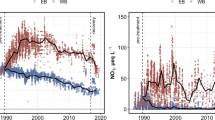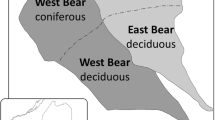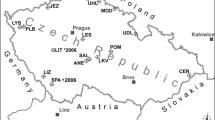Abstract
We examined long-term changes in soil solution chemistry associated with experimental, whole watershed-acidification at the Bear Brook Watershed in Maine (BBWM). At BBWM, the West Bear (WB) watershed has been treated with bimonthly additions of ((NH4)2 SO4) since 1989. The adjacent East Bear (EB) watershed serves as a biogeochemical reference. Soil solution chemistry in the EB watershed was relatively stable from 1989–2007, with the exception of declining SO4–S concentrations associated with a progressive decline in SO4–S deposition during this period. Soil solution chemistry in WB reflected a progressive change in acid-neutralization mechanisms from base cation buffering to Al buffering associated with treatment during this period. Total dissolved Al concentrations progressively increased over time and were ~4× higher in 2007 than in 1989. Treatment of WB was also associated with long-term increases in soil solution H+, SO4–S, and NO3–N, whereas soil solution dissolved organic carbon (DOC) was unresponsive to treatment. For solutes such as Ca, H+, and SO4–S, changes in stream chemistry were generally parallel to changes in soil solution chemistry, indicating a close coupling of terrestrial and aquatic processes that regulate the chemistry of solutions in this first-order stream watershed. For other solutes such as Al and DOC, solute concentrations were higher in soil solutions compared with streams, suggesting that sorption and transformation processes along hydrologic flow-paths were important in regulating the chemistry of solutions and the transport of these solutes.



Similar content being viewed by others
References
Aber, J., Mcdowell, W., Nadelhoffer, K., Magill, A., Berntson, G., Kamakea, M., et al. (1998). Nitrogen saturation in temperate forest ecosystems—Hypotheses revisted. BioScience, 48, 921–934.
Adams, M., Kochenderfer, J., & Edwards, P. (2007). The Fernow watershed acidification study: ecosystem acidification, nitrogen saturation and base cation leaching. Water, Air, & Soil Pollution: Focus, 7, 267–273.
Baker, J., & Schofield, C. (1982). Aluminum toxicity to fish in acidic waters. Water, Air, and Soil Pollution, 18, 289–309.
Bedison, J. E., & Johnson, A. H. (2010). Seventy-four years of calcium loss from forest soils of the adirondack mountains, New York. Soil Science Society of America Journal, 74, 2187–2195.
Bowman, W. D., Cleveland, C. C., Halada, L., Hresko, J., & Baron, J. S. (2008). Negative impact of nitrogen deposition on soil buffering capacity. Nature Geoscience, 1, 767–770.
Briggs, R. D., Hornbeck, J. W., Smith, C. T., Lemin, R. C., & McCormack, M. L. (2000). Long-term effects of forest management on nutrient cycling in spruce-fir forests. Forest Ecology and Management, 138, 285–299.
Brye, K. R., & Norman, J. M. (2004). Land-use effects on anion-associated cation leaching in response to above-normal precipitation. Acta Hydrochimica et Hydrobiologica, 32, 235–248.
Burns, D. A., Blett, T., Haeuber, R., & Pardo, L. H. (2008). Critical loads as a policy tool for protecting ecosystems from the effects of air pollutants. Frontiers in Ecology and the Environment, 6, 156–159.
Carnol, M., Ineson, P., & Dickinson, A. L. (1997). Soil solution nitrogen and cations influenced by (NH4)2SO4 deposition in a coniferous forest. Environmental Pollution, 97, 1–10.
Church, M. R. (1999). The Bear Brook Watershed manipulation project: Watershed science in a policy perspective. Environmental Monitoring and Assessment, 55, 1–5.
Courchesne, F., Côté, B., Fyles, J. W., Hendershot, W. H., Biron, P. M., Roy, A. G., et al. (2005). Recent changes in soil chemistry in a forested ecosystem of Southern Québec, Canada. Soil Science Society of America Journal, 69, 1298–1313.
Cronan, C. S. (1991). Differential adsorption of Al, Ca, and Mg by roots of red spruce (Picea rubens Sarg.). Tree Physiology, 8, 227–237.
Currie, W. S., Aber, J., & Driscoll, C. (1999). Leaching of nutrient cations from the forest floor: Effects of nitrogen saturation in two long-term manipulations. Canadian Journal of Forest Research, 29, 609–620.
de Vries, W., Reinds, G. J., & Vel, E. (2003). Intensive monitoring of forest ecosystems in Europe: 2: Atmospheric deposition and its impacts on soil solution chemistry. Forest Ecology and Management, 174, 97–115.
Dentener, F., Drevet, J., Lamarque, J. F., Bey, I., Eickhout, B., Fiore, A. M., et al. (2006). Nitrogen and sulfur deposition on regional and global scales: A multimodel evaluation. Global Biogeochemical Cycles, 20, GB 4003.
Dillon, P. J., & Molot, L. A. (1990). The role of ammonium and nitrate retention in the acidification of lakes and forested catchments. Biogeochemistry, 11, 23–43.
Dise, N., & Wright, R. (1995). Nitrogen leaching from European forests in relation to nitrogen deposition. Forest Ecology and Management, 71, 153–161.
Dise, N. B., Matzner, E., Armbruster, M., & MacDonald, J. (2001). Aluminum output fluxes from forest ecosystems in Europe: A regional assessment. Journal of Environmental Quality, 30, 1747–1756.
Driscoll, C., Driscoll, K., Mitchell, M., & Raynal, D. J. (2003). Effects of acidic deposition on forest and aquatic ecosystems in New York State. Environmental Pollution, 123, 327–336.
Elvir, J. A. (2004). Effects of enhanced nitrogen deposition on foliar chemistry, gas exchange, and forest growth at the Bear Brook Watershed in Maine. Ph.D. Thesis. Orono: University of Maine.
Fernandez, I. J., Rustad, L., David, M., Nadelhoffer, K., & Mitchell, M. (1999). Mineral soil and solution responses to experimental N and S enrichment at the Bear Brook Watershed in Maine (BBWM). Environmental Monitoring and Assessment, 55, 165–185.
Fernandez, I. J., Rustad, L. E., Norton, S. A., Kahl, J. S., & Cosby, B. J. (2003). Experimental acidification causes soil base-cation depletion at the Bear Brook Watershed in Maine. Soil Science Society of America Journal, 67, 1909–1919.
Fernandez, I. J., Karem, J. E., Norton, S., & Rustad, L. (2007). Temperature, soil moisture and streamflow at the Bear Brook Watershed in Maine (BBWM). Maine agricultural and forest experiment station technical bulletin 196, The University of Maine, 32pgs.
Fernandez, I. J., Adams, M., Sanclements, M., & Norton, S. (2010). Comparing decadal responses of whole-watershed manipulations at the Bear Brook and Fernow experiments. Environmental Monitoring and Assessment, 171, 149–161.
Fowler, D., Smith, R., Muller, J., Cape, J. N., Sutton, M., Erisman, J. W., et al. (2007). Long term trends in sulphur and nitrogen deposition in Europe and the cause of non-linearities. In P. Brimblecombe, H. Hara, D. Houle, & M. Novak (Eds.), Acid rain—Deposition to recovery (pp. 41–47). Netherlands: Springer.
Galloway, J. N., Dentener, F. J., Capone, D. G., Boyer, E. W., Howarth, R. W., Seitzinger, S. P., et al. (2004). Nitrogen cycles: Past, present, and future. Biogeochemistry, 70, 153–226.
Gustafsson, J. P. (2009). Visual MINTEQ version 2.61.
Houle, D., Ouimet, R., Paquin, R., & Laflamme, J. G. (1999). Interactions of atmospheric deposition with a mixed hardwood and a coniferous forest canopy at the Lake Clair watershed (Duchesnay, Quebec). Canadian Journal of Forest Research, 29, 1935–1943.
Hruška, J., Krám, P., McDowell, W. H., & Oulehle, F. (2009). Increased dissolved organic carbon (DOC) in Central European streams is driven by reductions in ionic strength rather than climate change or decreasing acidity. Environmental Science & Technology, 43, 4320–4326.
Huntress, D. W. (2008). Chemical dynamics during high discharge events at three forested catchments in Eastern Maine, USA (Master’s thesis). Orono: University of Maine.
Jefts, S., Fernandez, I. J., Rustad, L. E., & Bryan Dail, D. (2004). Decadal responses in soil N dynamics at the Bear Brook Watershed in Maine, USA. Forest Ecology and Management, 189, 189–205.
Kahl, J., Norton, S., Fernandez, I., Rustad, L., & Handley, M. (1999). Nitrogen and sulfur input–output budgets in the experimental and reference watersheds, Bear Brook Watershed in Maine (BBWM). Environmental Monitoring and Assessment, 55, 113–131.
Kraske, C. R., & Fernandez, I. J. (1993). Biogeochemical responses of a forested watershed to both clearcut harvesting and papermill sludge application. Journal of Environmental Quality, 22, 776–786.
Kruskal, W. H., & Wallis, W. A. (1952). Use of ranks in one-criterion variance analysis. Journal of the American Statisal Association, 47, 583–621.
Lawrence, G. B., Roy, K. M., Baldigo, B. P., Simonin, H. A., Capone, S. B., et al. (2008). Chronic and episodic acidification of Adirondack streams from acid rain in 2003–2005. Journal of Environmental Quality, 37, 2264–2274.
Lovett, G. M., Weathers, K. C., Arthur, M. A., & Schultz, J. C. (2004). Nitrogen cycling in a northern hardwood forest: Do species matter? Biogeochemistry, 67, 289–308.
Magill, A. H., Aber, J. D., Currie, W. S., Nadelhoffer, K. J., Martin, M. E., McDowell, W. H., et al. (2004). Ecosystem response to 15 years of chronic nitrogen additions at the Harvard Forest LTER, Massachusetts, USA. Forest Ecology and Management, 196, 7–28.
Majer, V., Krám, P., & Shanley, J. B. (2005). Rapid regional recovery from sulfate and nitrate pollution in streams of the western Czech Republic—Comparison to other recovering areas. Environmental Pollution, 135, 17–28.
Meiwes, K. J., Merino, A., & Beese, F. O. (1998). Chemical composition of throughfall, soil water, leaves and leaf litter in a beech forest receiving long term application of ammonium sulphate. Plant and Soil, 201, 217–230.
Monteith, D. T., Stoddard, J. L., Evans, C. D., deWit, H. A., & Forsius, M. (2007). Dissolved organic carbon trends resulting from changes in atmospheric deposition chemistry. Nature, 450, 537–540.
Murphy, J., & Riley, J. P. (1962). A modified single solution method for the determination of phosphate in natural waters. Analytica Chimica Acta, 27, 31–36.
Navrátil, T., Kurz, D., Krám, P., Hofmeister, J., & Hruska, J. (2007). Acidification and recovery of soil at a heavily impacted forest catchment (Lysina, Czech Republic)–SAFE modeling and field results. Ecological Modelling, 205, 464–474.
Navrátil, T., Norton, S., Fernandez, I., & Nelson, S. (2010). Twenty-year inter-annual trends and seasonal variations in precipitation and stream water chemistry at the Bear Brook Watershed in Maine, USA. Environmental Monitoring and Assessment, 171, 23–45.
Norton, S., Kahl, J. S., Fernandez, I., Rustad, L., Haines, T. A., Nodvin, S., et al. (1999). The Bear Brook Watershed in Maine (BBWM). Environmental Monitoring and Assessment, 55, 7–51.
Norton, S. A., Fernandez, I. J., Kahl, J. S., & Reinhardt, R. L. (2004). Acidification trends and the evolution of neutralization mechanisms through time at the Bear Brook Watershed in Maine (BBWM), U.S.A. Water, Air, & Soil Pollution: Focus, 4, 289–310.
Palmer, S., Driscoll, C., & Johnson, C. (2004). Long-term trends in soil solution and stream water chemistry at the Hubbard Brook Experimental Forest: Relationship with landscape position. Biogeochemistry, 68, 51–70.
Pellerin, B. A., Fernandez, I. J., Norton, S. A., & Kahl, K. S. (2002). Soil aluminum distribution in the near-stream zone at the Bear Brook Watershed in Maine. Water, Air, and Soil Pollution, 134, 189–204.
Reinhardt, R. L., Norton, S. A., Handley, M., & Amirbahman, A. (2004). Dynamics of P, Al, and Fe during high discharge episodic acidification at the Bear Brook Watershed in Maine, U.S.A. Water, Air, & Soil Pollution: Focus, 4, 311–323.
Rustad, L. E., Kahl, J. S., Norton, S. A., & Fernandez, I. J. (1994). Underestimation of dry deposition by throughfall in mixed northern hardwood forests. Journal of Hydrology, 162, 319–336.
Schulze, E. D. (1989). Air pollution and forest decline in a spruce (Picea abies) forest. Science, 244, 776–783.
Sherman, J., Fernandez, I. J., Norton, S. A., Ohno, T., & Rustad, L. E. (2005). Soil aluminum, iron and phosphorus dynamics in response to long-term experimental nitrogen and sulfur additions at the Bear Brook Watershed in Maine, USA. Environmental Monitoring and Assesssment, 121, 419–427.
Stern, D. I. (2006). Reversal of the trend in global anthropogenic sulfur emissions. Global Environmental Change, 16, 207–220.
Strahm, B. D., & Harrison, R. B. (2007). Mineral and organic matter controls on the sorption of macronutrient anions in variable-charge soils. Soil Science Society of America Journal, 71, 1926–1933.
Stumm, W., & Morgan, J. J. (1981). Aquatic chemistry: An introduction emphasizing chemical equilibria in natural waters (p. 780). New York: Wiley-Interscience.
Sullivan, T., Eilers, J., Cosby, B., & Vaché, K. (1997). Increasing role of nitrogen in the acidification of surface waters in the Adirondack Mountains, New York. Water, Air, and Soil Pollution, 95, 313–336.
Szillery, J.S. 2003. Soil solution dynamics in response to elevated nitrogen and sulfur treatments at the Bear Brook Watershed in Maine. doi:http://worldcat.org/oclc/62275814
Thompson, W. B., & Borns, H. W., Jr. (1985). Surficial geologic map of Maine: 1:500,000. Augusta: Maine Geological Survey.
Torres-Cañabate, P., Davidson, E., Bulygina, E., García-Ruiz, R., & Carreira, J. (2008). Abiotic immobilization of nitrate in two soils of relic Abies pinsapo forests under Mediterranean climate. Biogeochemistry, 91, 1–11.
Warby, R. A. F., Johnson, C. E., & Driscoll, C. T. (2009). Continuing acidification of organic soils across the Northeastern USA: 1984–2001. Soil Science Society of America Journal, 73, 274–284.
Waring, R. H., & Schlesinger, W. H. (1985). Forest ecosystems: Concepts and management. San Diego: Academic Press. 338 pp.
Watmough, S., Aherne, J., Alewell, C., Arp, P., Bailey, S., Clair, T., et al. (2005). Sulphate, nitrogen and base cation budgets at 21 forested catchments in Canada, the United States and Europe. Environmental Monitoring and Assessment, 109, 1–36.
White, G., Fernandez, I., & Wiersma, G. (1999). Impacts of ammonium sulfate treatment on the foliar chemistry of forest trees at the Bear Brook Watershed in Maine. Environmental Monitoring and Assessment, 55, 235–250.
Acknowledgments
We would like to thank the individuals and funding agencies that helped make this research possible. A special thanks to Cheryl Spencer for providing field and laboratory assistance. We also thank the laboratory and field staff, including the University of Maine Sawyer Environmental Chemistry Research Laboratory, John Cangelosi, Karen Small, Mary Beth Parent, Benjamin Lynch, and Anthony Drouin. Kevin Simon and Bryan Dail provided helpful comments to improve this manuscript. This research was funded, in part, by the Maine Agricultural and Forest Experiment Station and the U.S. National Science Foundation (DEB-0415348 and DEB-0210257). Graduate research fellowship support for this project was provided by the University of Maine Graduate School and the New England Farm and Garden Association. This manuscript has not been subject to agency or corporate review, and no endorsements should be inferred. This is Maine Agricultural and Forest Experiment Station Publication #2618.
Author information
Authors and Affiliations
Corresponding author
Rights and permissions
About this article
Cite this article
Fatemi, F.R., Fernandez, I.J., Szillery, J. et al. Soil Solution Chemical Response to Two Decades of Experimental Acidification at the Bear Brook Watershed in Maine. Water Air Soil Pollut 223, 6171–6186 (2012). https://doi.org/10.1007/s11270-012-1348-5
Received:
Accepted:
Published:
Issue Date:
DOI: https://doi.org/10.1007/s11270-012-1348-5




